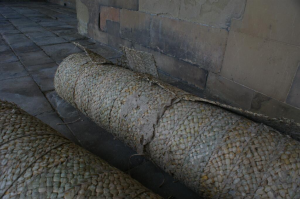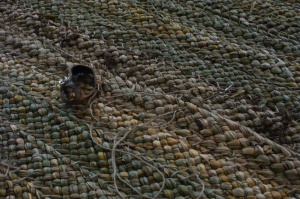Last week was the long-awaited matting week; when we finally got the new matting for the High Great Chamber! Hardwick has been waiting for this for a long time! I have talks about our flooring problems in a previous post you can read here.
Planning for this began a loooong time ago, and we originally has a week scheduled in May, and then September and for our new date last week we began preparing the room a fortnight ago. First we had to clear the High Great Chamber of all the furniture, and cover the Canopy to protect it from the dust that removing the old matting would stir up.
Then we had to begin the daunting task of clearing all the old matting out. As we could not afford to have the alcove matting replaced as well as the rest of the room we have to find a piece from the old matting to put here. Luckily part of the room is underneath at 16th Century rug and roped off from the public so was still in quite good condition. We measured the alcove and cut a piece to fit, storing it our of the way until the new matting was laid.
Next, in strips of about a meter wide we pulled up the old matting. To do this we had to cut the stitching between each strip, which is sewn with garden twine. Then the lengths were rolled, and as we did this we vacuumed underneath them to remove the dust and debris, and there was an awful lot! We filled at least five hoover bags and twice as many bin bags with the brown paper and dust that was underneath the matting.
It took us nearly an entire day to take up the matting, and then the next week the matters arrived. We spent monday morning carrying old rolls of matting down the Main Stairs and pushing new rolls up them! A bit of a work out indeed!
Then we could let the matters get on with their work. Long strips of rushes are plaited from hooks hanging on ceilings to the required length, and then these strips are sewn together to form pieces several feet wide. This is how the matting arrives and then the matters sew these rolls to one another on site. This is a really back-breaking job, I have no idea how the matters do it! They amazed me with their speed as well, finishing the whole thing in less than four days.
The matters use a large curved sail needle and go in-between the gaps in the rushed that make up the plaited strips. They have to use a really heavy-duty thimble that fits across their palm on a leather strap. After sewing all the pieces together edging strips are then sewn on to all the cut edges of the matting to stop it coming undone.
When it arrives it looks very different to matting that has been down a while. It is very textured and still green, and overtime becomes flattened down and beige. It also still really smells like the countryside, and when the room was completed it was a really nice feeling of having brought the outdoors in. It almost looked how fields look when you are flying above them in a plane. I can’t wait for our visitors reaction when they come in and see our beautiful new matting!
Here is a link to the website of the Matting company we use; Rush Matters.
















